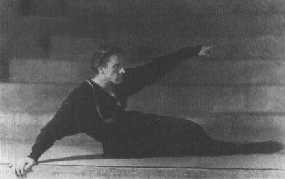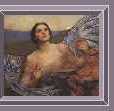
A Comparison of Kierkegaard and Hamlet
To see the page from which the image was taken, back up on the large image's URL.
Perhaps it's something in the water, or in the air, or in the general personality of the Danish, but one cannot read Kierkegaard's Sickness Unto Death - a treatise on the nature of despair and the human condition - without calling to mind the ringing soliloquies of Hamlet's desire for self-destruction. Can Kierkegaard's observations of the state of the majority of modern humanity be applied to the understanding of Hamlet, and from the verbose Hamlet, back to mankind, and the resolution and contentment of the self?
Kierkegaard opens Sickness unto Death by defining man and his self as "a synthesis of the infinite and the finite, of the temporal and the eternal, of freedom and necessity, in short it is a synthesis. A synthesis is a relation between two factors. So regarded, man is not yet a self" (Kierkegaard 340). The self one might consider the soul, that part of the human which is eternal. The Self being God.
From this, Kierkegaard defines despair as the "sickness unto death," whose torment is "not to be able to die" (Kierkegaard 341).  To whit: despair is the illness of the soul that, by definition, is immortal. Thus the reason he despairs is because he "cannot consume himself, cannot get rid of himself, cannot become nothing" (Kierkegaard 342). In one regard, then, despair is the ultimate and logical conclusion of the Devil's "I will not serve," for the despairing man refuses to accept himself as he is; he refuses his own existence.
To whit: despair is the illness of the soul that, by definition, is immortal. Thus the reason he despairs is because he "cannot consume himself, cannot get rid of himself, cannot become nothing" (Kierkegaard 342). In one regard, then, despair is the ultimate and logical conclusion of the Devil's "I will not serve," for the despairing man refuses to accept himself as he is; he refuses his own existence.
There are, not surprisingly, several variant levels of despair, dependent upon consciousness of the self versus consciousness of despair and understanding of both the self and despair. Again, the Devil is the example of a being that is perfectly aware of his self and his despair, with a full knowledge of what despair is. Hence, he is in the worst torment because of his complete understanding of what he is not and why (Kierkegaard 345). The majority of the world, especially those people whom Kierkegaard might label, along with Marx, the bourgeoisie, are blind to their own despair, or have an imperfect knowledge of what despair is, and certainly never truly know their selves in either case (Kierkegaard 352-353). The intermediary, then, is someone who recognizes his despair, and his incomplete self and either sinks deeper into despair, like the Devil; takes pride in his despair, like the clerical error (Kierkegaard 371); or is shaken by this realization and amends his life in accordance with the "Power" (God). For, regardless of what the despairing person wills, "the Power is stronger, and it compels him to be the self he does not will to be" (Kierkegaard 344).
In conjunction with these levels of despair are variations on who he is and who he desires to be. "A despairing man wants despairingly to be himself"(Kierkegaard 343; Italics mine), which is to say that a despairing man wants to be the self he presumes that he should be. To that end, a despairing man may despair over himself not being something (i.e., Caesar, or someone's beloved), or may despair over himself not being some other self (i.e., Napoleon, or his neighbor). Man can also despair over not being who he will be (or hopes to be) or who he was - the despairs of youth and age, respectively (Kierkegaard 359). Kierkegaard contrasts this latter despair, that is "not willing to be oneself" - the "despair of weakness" - with the despair of "willing to be oneself," that is willing to be a self apart from the source and only true self, God - the "despair of defiance" or "demoniac despair" (Kierkegaard 351, 365, 371).
Hamlet is a classic example of Kierkegaard's "despair of weakness." His first soliloquy begins with the desire for self-destruction, self-consumption, and self-transformation: "O that this too too sullied flesh would melt/Thaw, and resolve itself into a dew" (Shakespeare 38, Act I, Scene II)! His desire is for a different, purified self, a rebaptism of the self ("melt, thaw, dew"), for the "clerical error" to be erased and redrawn. His despair is not that pride of the self, or of man (whom he sees as "this quintessence of dust" [Shakespeare 70, Act II, Scene II]), but rather that man is not who he should be. Unfortunately, his idea of "should be" is split between the world's definition ("the courtier's, soldier's, scholar's, eye, tongue, sword,/The expectation and rose of the fair state,/The glass of fashion and the mould of form" [Shakespeare 84, Act III, Scene I]) and God's (to be).
Hamlet is Kierkegaard's introverted despairer. According to Kierkegaard, the introvert appears to be a "university man, husband and father, an uncommonly competent civil functionary even" (Kierkegaard 362). He is "a real man, clothed like others, or like others clad in the customary outer-garments" (Kierkegaard 362). Hamlet is a university man, a lover and a son, with the unfulfilled potential to be an uncommonly competent civil functionary. But as he says of himself, "I know not 'seems.'/'Tis not alone my inky cloak, good mother,/Nor customary suits of solemn black…/These indeed seem,/For they are actions that a man might play,/But I have within which passes show,/These but the trappings and the suits of woe" (Shakespeare 36, Act I, Scene II). Hamlet, the introvert, "seems" to be like any other man, but within is the consciousness of the incomplete self, and the fullness of despair.
Perhaps the best verbalization of Kierkegaard's despair is Hamlet's soliloquy in Act III, Scene I, "To be or not to be."  The entirety of this text has been most often, especially for purposes of the stage, interpreted as Hamlet's contemplation of suicide. The verb "be" might then be replaced with the word "live." And yet, one must give credit to the bard and puzzle why Shakespeare chose the passive form of the most common verb in the English language, when he was certainly not hampered by a lack of synonyms. Hamlet says, "To be or not to be" - a dialectal question. Is the implied direct object "myself," or, more properly, "a self" as Kierkegaard's assertion that despair is the despairing desire to "be himself?" The use of the infinitive (especially in juxtaposition to the later sentence "thus conscience does make cowards of us all) speaks to Hamlet's inability to act, his own passivity. He is, at this point, unable to act, afraid to act. He is on the verge of allowing his despair to "potentiate itself to a higher form and continue to be introversion" (Kierkegaard 364). He will "bear the whips and scorns of time" rather than actively seek faith and rectification. For an instant, we see Hamlet's reoccurring desire for death, ("when he might his quietus make with a bare bodkin;" referring to "Or that the Everlasting had not fix'd/His canon 'gainst self-slaughter!" [Shakespeare 38, Act I, Scene II]) that again coincides with Kierkegaard's description of such an introvert. "If this introversion is absolutely maintained…then suicide will be the danger nearest to him" (Kierkegaard 364). But just as Hamlet's deliberation turns towards that "dread of something after death" - Kierkegaard's "despair of the eternal" - in enters Ophelia, the embodiment of Kierkegaard's confidant.
The entirety of this text has been most often, especially for purposes of the stage, interpreted as Hamlet's contemplation of suicide. The verb "be" might then be replaced with the word "live." And yet, one must give credit to the bard and puzzle why Shakespeare chose the passive form of the most common verb in the English language, when he was certainly not hampered by a lack of synonyms. Hamlet says, "To be or not to be" - a dialectal question. Is the implied direct object "myself," or, more properly, "a self" as Kierkegaard's assertion that despair is the despairing desire to "be himself?" The use of the infinitive (especially in juxtaposition to the later sentence "thus conscience does make cowards of us all) speaks to Hamlet's inability to act, his own passivity. He is, at this point, unable to act, afraid to act. He is on the verge of allowing his despair to "potentiate itself to a higher form and continue to be introversion" (Kierkegaard 364). He will "bear the whips and scorns of time" rather than actively seek faith and rectification. For an instant, we see Hamlet's reoccurring desire for death, ("when he might his quietus make with a bare bodkin;" referring to "Or that the Everlasting had not fix'd/His canon 'gainst self-slaughter!" [Shakespeare 38, Act I, Scene II]) that again coincides with Kierkegaard's description of such an introvert. "If this introversion is absolutely maintained…then suicide will be the danger nearest to him" (Kierkegaard 364). But just as Hamlet's deliberation turns towards that "dread of something after death" - Kierkegaard's "despair of the eternal" - in enters Ophelia, the embodiment of Kierkegaard's confidant.
The relationship of Ophelia to Hamlet has often been disputed. She appears in no more than five scenes, speaks little, and seems to have no personality or "story" outside of Hamlet. She is what Kierkegaard describes on page 343 as that woman who despairs unless she can be "his" beloved, unless she can be a self defined by another. With this "seeming," one might assume that Horatio (who at least survives the finale) and not this "piece of bait" (Wofford 220) would be a better candidate. And yet Ophelia, and not Horatio, must be seen as Hamlet's Kierkegaardian confidant, for Horatio is the narrator - the play begins and ends with him, he is constantly at Hamlet's side, and has no opinions outside of Hamlet's. Ophelia, although little is known about her, is more truly Hamlet's confidant, especially in respect to Kierkegaard's observations on the role of the confidant to the introvert.
For example, in the "Get the to a nunnery" scene, which is preluded by Hamlet's "To be or not to be" speech, Ophelia shows her capacity for verbal interplay by taking the bait offered by Hamlet and rejoining, "Could beauty, my lord, have better commerce than with honesty?" By this one line, it could be inferred that such intellectual repartee was a normal part of their daily interactions. Indeed, it would almost seem necessary given Hamlet's introspective disposition that the woman he loves would be able to "keep up" with him on an intellectual level.
Ophelia interrupts Hamlet's bloody musings with her mere presence, making Hamlet react in the manner Kierkegaard predicted: Hamlet immediately "shuns suicide" (Kierkegaard 365).  He even asks Ophelia to be his intercessor: "Nymph, in thy orisons/Be all my sins remembered." But Ophelia, his confidant, has come to betray him, as everyone else in the court has already, by siding with her father and returning (although much against her will) Hamlet's love-letters. In modern terms, she has come to "break up." With this betrayal, Hamlet reacts again in the manner described by Kierkegaard: he verbally murders Ophelia.
He even asks Ophelia to be his intercessor: "Nymph, in thy orisons/Be all my sins remembered." But Ophelia, his confidant, has come to betray him, as everyone else in the court has already, by siding with her father and returning (although much against her will) Hamlet's love-letters. In modern terms, she has come to "break up." With this betrayal, Hamlet reacts again in the manner described by Kierkegaard: he verbally murders Ophelia.
When Ophelia, after having gone into a deep despair over not being "his beloved" anymore (Act IV, Scene V) is able to finish what Hamlet began in Act III by committing suicide, Hamlet is finally able to cry an unmitigated "I loved Ophelia" (Shakespeare 139, Act V, Scene I), rather than the weak "I did love you once" (Shakespeare 83, Act III, Scene I). Alas, this is Kierkegaard's "agonizing self-contradiction in a demoniac man who is not able to get along without a confidant, and not able to have a confidant" (Kierkegaard 365).
Every scene in Hamlet, whether with Ophelia, Horatio or even Osric, is designed to corner the noble prince into a place where he must either yield to what he is, to look upward to the Eternal Power, and accept that he is impotent when relying on his own power; or to break through those opposing forces into the fullness of madness and despair. Either way, Hamlet is being slowly forced to action. And, as Hamlet says, either way that action will be bloody ("O, from this time forth,/My thoughts be bloody, or be nothing worth" [Shakespeare 116, Act IV, Scene IV]!). From the course of the action, the audience expects either his own self-slaughter (although this seems improbable now that he has actually committed several homicides and is planning others), or at the very least the death of Claudius. Shakespeare gives us both deaths - and Laertes and Gertrude as well - yet in an initially unsatisfying manner.
Hamlet's death is almost accidental. The wound he receives is relatively minor, and certainly not fatal, except that the tip of the weapon was poisoned - hence Hamlet dies. But regard the other deaths as well. None of them are bloody; they all spring from the self-same poison. First Gertrude who mistakenly drinks from the fatal cup: symbolic of her first fatal assent to marry Claudius. And Laertes: more quickly poisoned, again by Claudius's shrewd words, and poetically, Laertes's own treachery. Then Claudius: forced by Hamlet to drink from the poisoned cup. (With this act, the audience is thereby forced to reevaluate who the true poisoner is.) And finally Hamlet: the poison within the court, the "something rotten in the state of Denmark" - but only because of the universal poison: Despair.
The universal poison: Despair.
Is this then the fascination Hamlet has over us? This monstrous play of the deadly effects of despair; this warning to the spectator to eradicate the poison within themselves, within the water and the air not only of Denmark but of all Mankind - Despair? Certainly. For despair, as Kierkegaard describes it is no more than that fault of human nature as ancient as our first parents: sin. "This is sin; and its opposite is not virtue, but faith" (Kierkegaard 341). But Hamlet put faith in his mother, in Ophelia, in Rosencrantz and Guildenstern, and they all betrayed him, how then may one have faith? By putting faith first in God, and not in our fellow fallen man. Hamlet and Sickness unto Death are two poignant reminders, two "wake-up" cries to modern man to come out of the sinful, the self-destructive despair, and to turn to the Eternal, the Power - to God - for assistance in "becoming." So that instead of questioning whether to be, or not to be, we may, in obedience to the Great I AM say, "I am whom He made me to be."
1. Kierkegaard. "Exerpts from The Sickness unto Death." Readings: Honors VII. Ed. Dominic A. Aquila. (Steubenville, OH: Franciscan University of Steubenville Copy Shop, © 1998).
2. Shakespeare. Hamlet. Ed. Susanne L. Wofford. (New York: St. Martin's Press, Inc., © 1994).
3. Showalter, Elaine. "Representing Ophelia: Women, Madness and the Responsibilities of Feminist Criticism." Hamlet. Ed. Susanne L. Wofford. (New York: St. Martin's Press, Inc., © 1994).
 Top
Top




 (c) 19 November, 1998
(c) 19 November, 1998
Updated 13 June, 2000
All Rights Held by the Author.
No part of these pages may be used or copied without express permission of the author.